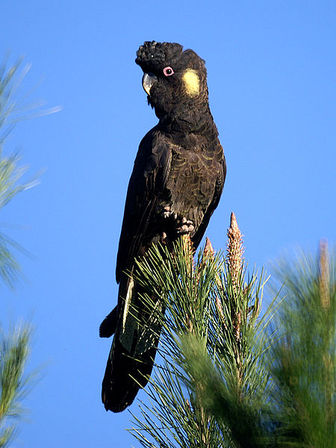Yellow-tailed Black-Cockatoo
The Yellow-tailed Black Cockatoo is a large cockatoo native to the south-east of Australia measuring 55–65 cm in length. It has a short crest on the top of its head. Its plumage is mostly brownish black and it has prominent yellow cheek patches and a yellow tail band. The body feathers are edged with yellow giving a scalloped appearance. The adult male has a black beak and pinkish-red eye-rings, and the female has a bone-coloured beak and grey eye-rings. In flight, Yellow-tailed Black Cockatoos flap deeply and slowly, and with a peculiar heavy fluid motion. Their loud eerie wailing calls carry for long distances.

Original source: originally posted to Flickr as Yellow-tailed Black-Cockatoo (Calyptorhynchus funereus)
Author: David Cook Wildlife PhotographyPermission(Reusing this file)This image, which was originally posted to Flickr.com, was uploaded to Commons using Flickr upload bot on 14:28, 23 February 2009 (UTC) by Snowmanradio (talk). On that date it was licensed under the license below. This file is licensed under the Creative Commons Attribution-Share Alike 2.0 Generic license.You are free:to share – to copy, distribute and transmit the work
The Yellow-tailed Black-Cockatoo is classified as Least Concern. Does not qualify for a more at risk category. Widespread and abundant taxa are included in this category.
The Yellow-Tailed Black-Cockatoo is one of six species of Black-Cockatoo in Australia. In recent years it has been in rapid decline because of native habitat clearance, with a loss of food supply and nest sites. More
Yellow-tailed Black-Cockatoo, Calyptorhynchus funereus, in Eucalyptus regnans forest, and implications for forest management". Wildlife Research 21 (3): 267–78. doi:10.1071/WR9940267. 41. ^ Wapstra, Mark; Doran, Niall (2004). (fulltext) "Observations on a nesting hollow of Yellow-tailed Black Cockatoo, and the felled tree that hosted it, in northeastern Tasmania". Tasmanian Naturalist 126: 59–63. http://www.tasfieldnats.org.au/TasNatArticles/TasNat126/TN126-WAPSTRA. More
Yellow-tailed Black-Cockatoos Calyptorhynchus funereus are found throughout south eastern Australia in SW Queensland, eastern NSW, Victoria, Tasmania, Bass Strait islands and southern South Australia. Yellow-tailed Black-Cockatoos are not listed as nationally threatened, however in South Australia, Yellow-tailed Black-Cockatoos are considered Vulnerable under the National Parks and Wildlife South Australia (NPWSA) Wildlife Schedules 2000. The Eyre Peninsula Yellow-tailed Black-Cockatoo population is isolated from other mainland and island populations (including Kangaroo Island) and has undergone dramatic decline since European settlement. More
The Yellow-tailed Black-Cockatoo is a large (55 - 65 cm) cockatoo. It is easily identified by its mostly black plumage, with most body feathers edged with yellow, not visible at a distance. It has a yellow cheek patch and yellow panels on the tail. The female has a larger yellow cheek patch, pale brown bill (grey-black in males) and black marks in the yellow tail panels. Young birds resemble the adult female, but young males have a smaller cheek patch. More

Original source: *Bird_range_yellow-tailed_black_cockatoo.png: User Kiwifruitboi on en.wikipedia *derivative work: Snowmanradio (<
Author: *Bird_range_yellow-tailed_black_cockatoo.png: User Kiwifruitboi on en.wikipedia *derivative work: Snowmanradio (<
Permission: Some rights reserved
Family : Psittacidae
Genus : Calyptorhynchus
Species : funereus
Authority : (Shaw, 1794)
